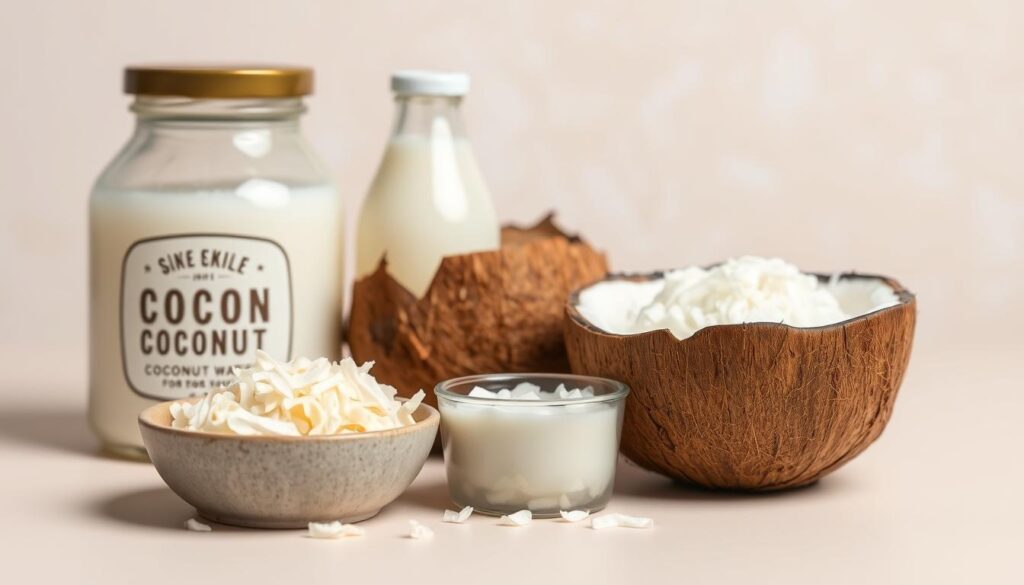Can Dogs Have Coconut? Benefits and Risks Explained
Ever watched your furry friend eyeing your tropical smoothie? Many pet owners wonder about sharing coconut treats. This tropical fruit has gained popularity in pet nutrition, but opinions remain divided.
Good news: The flesh, milk, and oil aren’t toxic for pets. Lauric acid offers immune support, while antioxidants promote skin health. Purina even includes it in some commercial formulas.
However, moderation matters. High fat content may trigger pancreatitis or digestive upset. Sweetened products pose serious dangers due to potential xylitol content. Always consult your vet before introducing new foods.
This guide explores the balance between health benefits and potential risks. You’ll learn proper portion sizes, safe preparation methods, and warning signs to watch for.
Table of Contents
Can Dogs Have Coconut? Safety First
Your pup’s curious nose might sniff out coconut treats during snack time. While the ASPCA confirms it’s non-toxic, moderation and preparation matter. Not all forms are equally safe.
Understanding the Risks
The flesh and oil contain medium-chain triglycerides (MCTs), which metabolize faster than long-chain fats. However, high-fat content still risks pancreatitis—especially in breeds like Schnauzers or overweight pets.
Watch for: vomiting, diarrhea, or lethargy after ingestion. These signal immediate action is needed. Husk or shell pieces? They’re choking hazards and may cause intestinal blockages.
When to Call the Vet
Consult your vet if your pet has:
- Pre-existing conditions (e.g., diabetes)
- A prescription diet
- Ingested large amounts accidentally
Keep the Pet Poison Helpline handy: 888-426-4435. For safe introduction, follow Purina’s tip: Start with a pea-sized amount of coconut oil and monitor their stomach reaction.
Health Benefits of Coconut for Dogs
Tropical ingredients aren’t just for human consumption—they can support pet wellness too. Packed with lauric acid and antioxidants, this fruit offers unique advantages when used responsibly.
Immune System Support
Lauric acid converts to monolaurin, a compound studied for its antimicrobial properties. While research on canine influenza is limited, it suggests potential defense against pathogens. Manganese, another key nutrient, aids joint health in active pets.
Antioxidants in coconut rival those in blueberries, combating oxidative stress. Dr. Angela Rollins notes its anti-inflammatory effects, which may ease skin conditions.
Skin and Coat Benefits
Topical coconut oil soothes cracked paws and hotspots. Its moisturizing properties stem from medium-chain triglycerides (MCTs), which also support cognitive function in older pets.
Coconut flour’s high fiber content promotes digestion, but avoid substituting it for essential fatty acids like omega-3s. Balance is key to maximizing health benefits.
What Coconut Products Can Dogs Have?

Not all coconut-based foods are created equal when it comes to pet safety. While some offer health perks, others hide serious risks. Here’s a breakdown of what’s safe and what to avoid.
Coconut Meat: Tiny Portions Only
Fresh or dried, coconut meat is safe in minimal amounts. For extra-small breeds, stick to 1/8 teaspoon daily. Shred it finely to prevent choking—large pieces may cause blockages.
Pro tip: Opt for unsweetened varieties. Added sugars spike calorie counts and offer zero nutritional value.
Coconut Oil: Dosage Matters
This popular supplement supports skin health and digestion. But overuse risks pancreatitis. Follow Purina’s guideline: 1 teaspoon max per day for large breeds.
Milk and Water: Hidden Dangers
Coconut milk packs 17% fat—equivalent to heavy cream. Even small servings may trigger stomach upset. Water seems harmless, but 90% of commercial brands contain xylitol, a deadly sweetener for pets.
Steer Clear of These
Avoid husks (choking hazard), sweetened flakes, and exotic products like macapuno strings. The FDA reports 127 coconut-related pet emergencies since 2019, mostly from improper preparation.
| Product | Safety Rating | Max Daily Amount |
|---|---|---|
| Fresh coconut meat | ★★★☆☆ | 1/8 tsp (XS dogs) |
| Coconut oil | ★★★★☆ | 1 tsp (large dogs) |
| Unsweetened milk | ★★☆☆☆ | Not recommended |
| Commercial water | ★☆☆☆☆ | Avoid entirely |
Store coconut products in airtight containers to prevent rancidity. When in doubt, consult your vet before sharing that tropical treat.
Potential Risks of Feeding Coconut to Dogs

While coconut offers benefits, pet owners must recognize its hidden dangers. Even small amounts may trigger severe health issues, especially in susceptible breeds.
High Fat Content and Pancreatitis
One cup of shredded coconut packs 283 calories—33% from saturated fat. For a 10-pound pet, just 1 teaspoon of oil equals 10% of their daily calorie needs.
Pancreatitis-prone breeds require extra caution:
- Schnauzers
- Cocker Spaniels
- Yorkies
AVMA reports 12% of dietary-induced pancreatitis cases stem from high-fat treats. Symptoms like vomiting or lethargy demand immediate vet care.
Choking Hazards and Blockages
Husk pieces cause 40% more incidents in coastal states. Their rigid fibers can lodge in the trachea or intestines.
Endoscopic removal costs $1,500–$3,000. Prevent accidents by:
- Avoiding whole coconut chunks
- Supervising chew sessions
- Learning pet Heimlich maneuvers
Fiber overload from coconut flour may also cause digestive issues. Balance treats with regular meals to avoid long-term obesity risks.
How Much Coconut Can Your Dog Eat?
Size matters when introducing tropical treats to your furry companion. Proper amounts vary dramatically between Chihuahuas and Great Danes. Follow these evidence-based guidelines to balance nutrition and safety.
Tailored Portion Recommendations
Veterinary nutritionists recommend scaling portions to body weight. Extra-small breeds should start with rice-sized amounts, while large pets can handle teaspoon quantities.
| Weight Range | Meat (Daily Max) | Oil (Daily Max) |
|---|---|---|
| Under 10 lbs | 1/8 tsp | 1/4 tsp |
| 10-30 lbs | 1/4 tsp | 1/2 tsp |
| 30-60 lbs | 1/2 tsp | 3/4 tsp |
| 60+ lbs | 1 tsp | 1 tsp |
“Treat calories should never displace essential nutrients from complete meals.”
The Science Behind the 10% Rule
Nutritionists cap treat intake at 10% of daily calories. For a 20-pound pet needing 550 calories, that’s just 55 treat calories—about 1.5 teaspoons of coconut meat.
Compare portions:
- 1 tsp oil = 40 calories (2 Milk Bones)
- 1 tbsp flakes = 35 calories (1 Greenie)
Adjust main meals when giving coconut. Reduce kibble by 1/8 cup for every 100 treat calories. Mobile apps like Pet Nutrition Calculator help track totals.
For weight management, monitor body condition weekly. Ribs should feel like a knuckle-covered hand—not visible but easily palpable. Spayed pets need 20% fewer calories than intact animals.
Creative Ways to Feed Coconut to Your Dog
Transform mealtime into a tropical adventure with these clever coconut ideas. Whether masking medication or baking wholesome snacks, this versatile fruit adds flavor and nutrition.
As a Pill Coating
Struggling with stubborn pills? A dab of coconut oil makes them irresistible. Follow this vet-approved method:
- Step 1: Melt 1/4 teaspoon oil until liquid (microwave 5 seconds).
- Step 2: Roll the pill in oil, then coat with peanut butter.
- Step 3: Freeze for 10 minutes to set the texture.
Pro tip: Use silicone molds for uniform portions. One rescue owner reported 90% success with this hack for anxious pets.
Homemade Coconut Treats
Skip store-bought snacks with these simple recipes. Coconut flour works perfectly for wheat-sensitive pets—swap 1 cup wheat flour for 1/3 cup coconut flour plus extra liquid.
“Homemade treats let you control ingredients, avoiding preservatives and excess sugar.”
Three vet-approved ideas:
- Frozen Cubes: Blend 1/2 cup coconut water, 1/4 cup pumpkin purée, and freeze in ice trays.
- Crunchy Biscuits: Mix 1/2 cup coconut flour, 1 egg, 1/4 cup unsweetened applesauce. Bake at 350°F for 20 minutes.
- CBD Infusion: Add 1–2 drops of vet-approved CBD oil to melted coconut oil for anxious pets.
Avoid common mistakes: Overbaking dries out treats, while honey spikes sugar content. Store in airtight containers—frozen treats last 2 months, baked ones 1 week.
Conclusion
Every pet reacts differently to new foods—caution comes first. Stick to moderation: 1 teaspoon of oil max, avoid husks, and check labels for xylitol. Even safe amounts may upset sensitive stomachs.
Treat coconut as a supplement, not a staple. Track reactions in a journal and schedule regular weight checks. Pets on prescription balanced diets need vet approval before trying tropical additions.
For emergencies, save the Pet Poison Helpline: 888-426-4435. Purina’s nutritionists offer free vet consultation at 1-800-778-7462. Download their quick-reference guide for coconut safety tips.
FAQ
Is coconut toxic to dogs?
No, coconut isn’t toxic, but certain parts (like husk or sweetened products) can cause digestive issues. Always remove the shell before feeding.
Can coconut oil improve my dog’s coat?
Yes! The fatty acids in coconut oil promote a shiny coat and healthy skin. Use small amounts to avoid stomach upset.
How much coconut meat is safe for dogs?
Stick to tiny portions—about 1 teaspoon per 10 lbs of body weight. Too much can lead to diarrhea due to high fat content.
Are coconut water or milk safe for dogs?
Plain coconut water in moderation is fine, but milk contains fats that may cause pancreatitis. Avoid sweetened or flavored varieties.
What coconut products should dogs avoid?
Steer clear of husks, shells, and sweetened items (like shredded coconut). These pose choking hazards or contain harmful additives.
Can coconut help with my dog’s digestion?
In small doses, coconut meat or oil may aid digestion, but overfeeding can cause stomach upset. Introduce slowly.
How often can I give my dog coconut treats?
Follow the 10% rule—treats (including coconut) should make up less than 10% of your pet’s daily calorie intake.
Does coconut support a dog’s immune system?
Yes! Lauric acid in coconut has antibacterial properties, but balance it with a vet-approved diet for full benefits.





